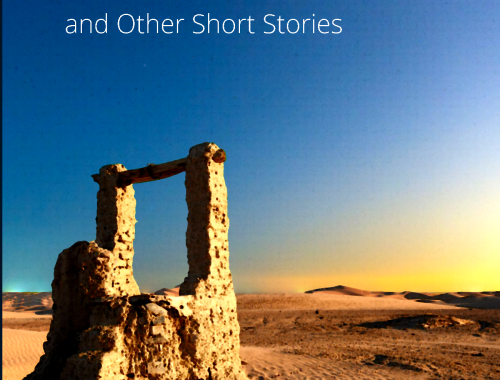Travel letter from Romania – with vampires
A country can either heal itself or lay the groundwork for a new kind of misery.
The future depends on the way you handle your past in the present.
Like it or not. What should be said is, that Ceaucescu actually had great political courage, dared to go against the Soviet line in his time, protested against the invasion of Czechoslovakia and refused to send troops to quell the uprising in 68. This actually made him popular in the West and together with Marshal Tito unpopular with the Soviet Stalinists. During a state visit to Denmark, he even received the Order of the Elephant as a somewhat embarrassing reward for political correctness in the Cold War mentally poisoned and black-and-white era. The embarrassment was completely on the side of the Danes. Was there anything wrong with the royal house not being allowed to conduct politics?
At the time, Romanians were happy to get rid of the 42-year-old communist regime, the secret perfidious police Securitate, the Russian presence and their paranoid and repressive regime. 25 years later, however, it is rumored that 60% of all Romanians would vote for Ceaucescu if he stood up from the grave and stood for election. People longed for the security of the collectivized society, where no one was really unemployed. Others became disillusioned that the West they had idolized and longed for, now turned out to have its, shall we say: clear backsides. Predatory capitalism was not paradise on earth. Illusion in the east, illusion in the west.
Some years ago, Romanians became somewhat divided over, how to deal with what was happening in Ukraine. Their old hatred of the Russians from the communist era still sat in them. Ceaucescus’ distancing from the Russians may explain something. The Romanians are not Russians either, they are not even slaves. They are rather Romans. Or rather: they are an ancient culture that was at one time occupied by the Roman Empire. One recognizes it in language, but as we shall soon understand, that the logic is reversed. I was trying to teach myself to count to a hundred in Romanian, and it’s pretty much like counting in Roman-Italian: Unu, doi, trei, patru (like quattro), cinci, sase (like sei / sextus), etc… One can almost read inscriptions on walls and buildings and road signs. Suffixes on words are ‘ul’ and not ‘o’, a lake is called lagul and not lago. A dragon is called a dracul.
So the Romanians were not inclined to side with the Russians when they were attacked by NATO, the Pentagon and the EU. They had recently joined the EU and were happy about it for the time being. For the time being that is, because as they slowly discovered how corrupt the EU system was, they became more apprehensive. They had not yet experienced how the EU first gave with one hand and then took everything and much more with the other, for the unfathomable part of the trip had not come to them yet. Otherwise, they should know, because their neighbor to the south is Greece, and their border on the Black Sea is Ukraine, both countries that experienced the financial terrorism of the EU and the global central banking systems at the same time.
The EU strategy was for a period to support e.g. agriculture and industry in Southern Europe, it was here that the industrialists saw the cheap labor. Then came enlargement to the east, so the industrialists shifted their support to the region. At the same time, they slaughtered and plundered southern Europe. The Treaty of Rome is not signed in Rome for nothing – on blank paper by the way, but that’s a different story (ask former Danish foreign minister Uffe Ellemann, but he will never admit the scam). Spain subsequently had an unemployment rate of 25% / youth unemployment of 50%, and today the opposition has been blown out of proportion. The Romanians had not fully followed the lesson and were fooled into the schedule.
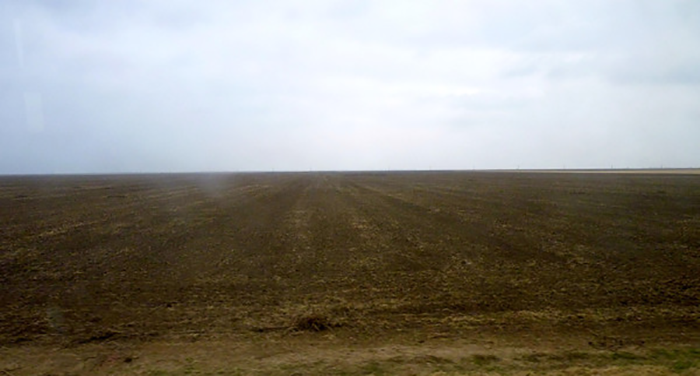
Romania is mostly an agricultural country and, of course, hoped to benefit from EU support for agriculture. They did not fully understand that their country did not have the same value to the EU as the fat, black soil of Ukraine, which along with its other rich resources was attacked and plundered. But they have enough land. When you drive in the arduous train from Bucharest towards the coastal city of Constanta on the Black Sea and further north to Tulcea south of the Danube Delta, my destination, you drive through a landscape of endless fields. Fascinating in its own way. Not like other places, e.g. Denmark, where the landscape is subdivided by small stamps, not even as Danish manor land, where the fields extend all the way to the nearest forest edge. The fields in Romania stretch until you can no longer see them on the horizon without a tree in between! These were the state farms under communism, and therefore there was neither room for nor need for subdivision. The Mongols and Huns must have loved Eastern Romania, here there was room for horses! The Magyars and Mongols have rocked at full speed with their hair back.
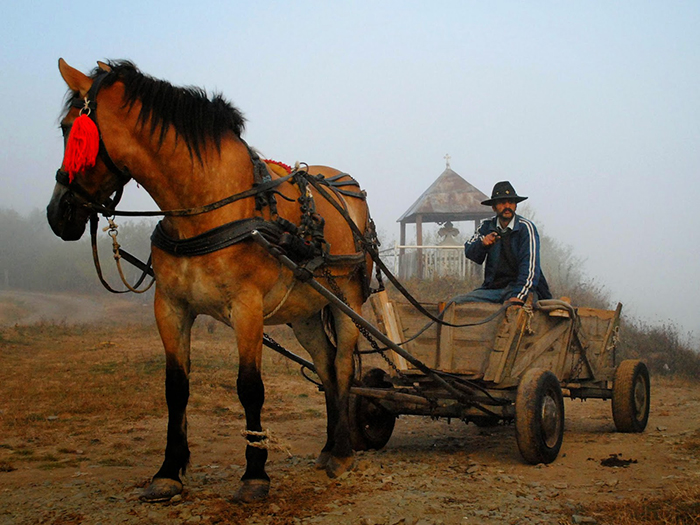
You can still meet the farmer and his horse-drawn carriage on the country road.
The Middle Ages and modernism live side by side.
I admit that I have not traveled Romania thin. Next time I will see the Transylvanian mountains. In return, I sailed in the huge river delta from the Danube, Europe’s largest. I have seen 10 million water lilies, herons, cormorants and giant white pelicans eating 15 kg of fish a day. And I know that a catfish lives there so large, that it can swallow a dog in one mouthful. I’ve eaten a grilled chunk of its little brother.
This is admittedly not a tourist advertisement, but you can hire a taxi for 100 lei, approx. 6.5 $ kr and drive 50 km. A 340 km taxi ride from Bucharest to Uzlina would have cost 600 lei, the train ride cost 68 lei. As a Dane, you are a wealthy person in this country, and you meet almost only nice people. A normal city taxi ride costs around DKK 1.2$ ! You almost have to tip well to not get a little embarrassed. A meal with several dishes and it all costs a maximum of 80 lei in the hot neighborhood of Bucharest, the Old Town. What they lack in hyper-trendiness, they have in solidity and tradition.
For Bucharest is neither Berlin nor Paris fancy, although it is certainly going on in certain places. But 100 years ago, the city was still called ‘Little Paris’. In between the ugly ravages of Soviet modernism, one still finds old Bucharest. In some places it may seem overdue and in default, such as Prague and Budapest, before they came to money. Between the renovated palace-like buildings belonging to banks, government and military, there is a wealth of small and large magnificent 19th century buildings with shelled facades, brown city grease and rusty metal grilles. There is a certain nostalgia and vanished grandeur over the street scene, 3D photographs of the past. There is a calm rhythm. Decay aesthetics.
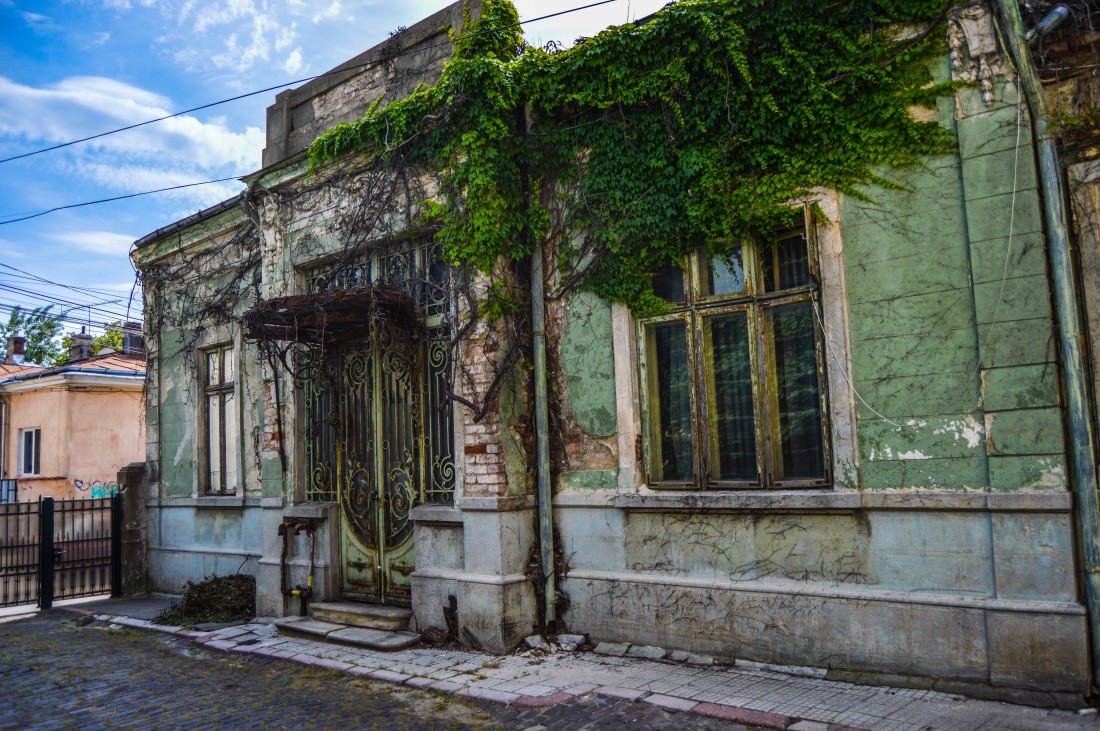
A certain decay
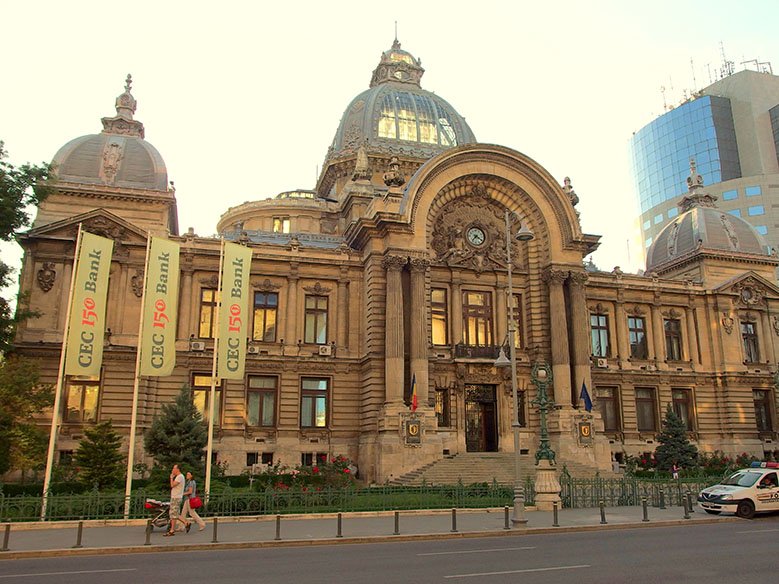
And splendour – side by side
The ugliness is there too. The parliament is not really ugly, it’s just monstrous and typical of the time, but are parliaments not always?
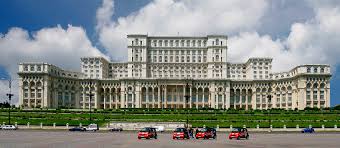
By comparison, take a walk in your own hood and surroundings and see how concrete modernism has ravaged here. Is there anything to brag about? See the inconsolable social democratic social housing developments. See the endless suburbs of Copenhagen with rental barracks on the strip. See the destruction of the villages and the leveled landscape. See the villa and townhouse neighborhoods with their asshole privet conformity. High standard of living we call it, but in its essence unimaginative. I find it difficult to see the qualitative and aesthetic difference between this, and what tourists call the Ceaucescu style – which in reality is from the Russian period and Danish standardization culture. Scandinavia is right now becoming the new collectivist experiment, the new soft internalized Soviet starts here, and the EU-SSR is its uncle.
The Romanians even have a cultural advantage over the Danes: they have not yet become historyless.
The man they called Vampire
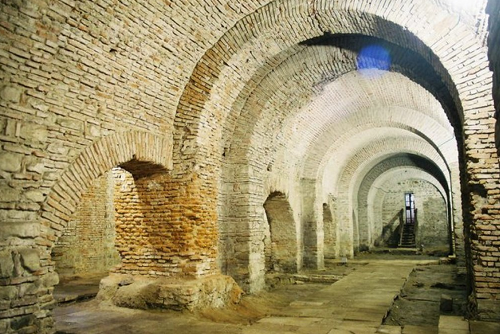
The basement under the old Princely Court
We jump back in history. In the building of the old princely court, Curtea Veche, there is another form of restored decay aesthetics. It is the oldest building complex in the city and only the basement complex is well preserved after fires and earthquakes. Above the entrance to the basement we find a statue of a remarkable figure in Romanian history from a time when the name Romania was not in use, the former owner of the place, one might say. The land around Bucharest was called Valachia and its ruler in the 15th century was named Vlad (Prince) Tepech. He was also known as Vlad Dracul because, like his father, he was a member of a knightly Order of the Dragon (dracul). By twisted detours, he has ended up as a novel and film character known as Count Dracula. And not without reason, because the name ‘Tepech’, in English means the Impaler. He simply placed the heads of his defeated enemies on poles. From here, Bram Stokers has his plot with piles and cellars, but also from here the similarities end.

Vlad saw as a young prince, that the country was in decay. Trade, crafts and agriculture had stagnated, the country had ended up in the hands of the ‘boyars’, lower nobles, who with Turkish back cover had seized land and possessions and merely bloodsucked – to stay in the vampire language – the country in their own favor. His response was to mobilize and then tip them off then expel and in most cases execute them. No nonsense. Nor so much nonsense, as the Turks under Mehmet II later claimed the land by demanding that tribute be paid. Tribute was equal to submission and admission that Valachia was part of the Ottoman Empire. Vlad refused, and when the Turks arrived with envoys and 2,000 men, they were thrown into prison. The Turks sent a punitive expedition of 20,000 men, but on the way from Bulgaria to Valachia they were greeted by the macabre sight of the heads of the 2,000 envoys … on poles! Some already desserted at the sight. The rest were captured and perished in a narrow passage along the way. And where have we heard of this tactic before? It was the same tactics, that the Germans used in the year 9 BC, when they slaughtered three invading Roman legions in the Theotoburg forest, that were to make a final inroad into Northern Europe. History was known for posterity, and the Wallachians were allied with the Germans, who knew their own history. They could also tell about how their Danish allies stopped the heirs of the Roman state, the Roman Church and the French imperialists at Dannevirke, and later stopped the Franks and the British by becoming: Vikings.
Heads on poles, the ugliness and horror of war. As a rule, quite unknown by those who order the work. Take and send a stack of Danish ministers on a tourist trip to a Libyan desert, to Felluja province in Iraq, to Afghanistan, to Homs in Syria. Give them a nice tour of Ukraine so they can see what their foolish decisions have spawned of misery and genocide, and what perfidious crooks the Danish taxpayers are paying money for. Let them experience on their own body what they in their corrupt, imbecile convenience have helped to decide at the expense of the Danes. And let the Danes know exactly what is going on, so that they can understand that they are fully complicit, as long as they do not say no.
So he was no mister Nice Guy, that Prince Dracul. But we must also understand that was a heroic figure of several peoples in his time and far into posterity. And even today. Both the Greeks and the Hungarians have, so to speak, a certain understanding of his exploits. It was no trifle as a local prince, to set himself up against the leading Empire of the time and even successfully. Later, he was betrayed by his own brother, Radu the Beautiful, who, like another Prince John in the folklore story of Robin Hood had made a deal with the Turks and became a new boyar, a usurper in the absense of his own brother.
Vlad sought help from Matthias Corvinus, the Hungarian king and former ally. Instead of help, he was given 12 years in Hungarian prison. Not so much because the Hungarians were his enemies, but because also the Papal Power had begun to fear his efficiency and contempt for Empires, and because the Hungarian king after his own wars could not afford to stand up to them. So he made a dirty agreement with the Catholics to appease them when Vlad sought refuge. After imprisonment, Vlad was released and made a brief comeback. He died in December 1476, aged 45, on a expedition to an unknown place in southern Romania or Bulgaria, and his burial place is unknown today.
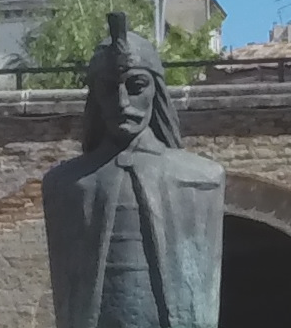
Half in shadow, half in light
It has been claimed that he was buried in an untitled grave in a monastery outside Bucharest. But when the tomb was opened, it was empty. Uhuuh… more stuff for legends about vampires rising from the grave. The right place is rather the Comana Monastery near Giorghiu on the border with Bulgaria. The monastery was built by Vlad as a fortified monastery, and excavations in the 1970s found a skeleton without a head. With the irony of fate, Vlad, the Empaler, may have ended his days with his head on a pole.
Today we can see a bust of this grim but fascinating figure at the ruins of the Prince’s Palace. Notice the nicely curved mustache. We leave the fangs to Bram Stoker and Bela Lugosi, who played the vampire in the 1931. ‘Hai hamm Drac-culaa. Vell-camm…‘ (theatrical Hungarian-Transylvanian accent with slightly saliva).
A forgotten chapter in European history
How come, we are talking about Romania as the new Rome, and how come we have been told that the Romanians were romanized and Latinized, and that their language is a slightly distorted version of the ‘real’ Roman Latin, as the Romans spoke?
The Romans had only occupied part of the country for 160 years. Elsewhere as England, Egypt and Palestine, they were for between 400-800 years without leaving any such all encompassing traces in the language. Secondly, we must understand that the Roman soldiers did not speak Latin at all, which is an artificial language reserved for the elite, but rather what was called vulgata, or vulgar = ordinary Roman. There is something wrong with the writing of history, which probably does not come as a surprise to readers of the mellemsteetage.
The Romanians themselves were taught a false story about themselves in school being descendants of Romans. It wastaught, that all the prisoners of the Roman Empire would be released if they helped the emperor overthrow Dacia, as it was then called. Only recently has a more genuine history writing begun to flood the media and partly because of the internet. But history has always been known by special people, for or it would not have been reconstructed. Like, for example, the country’s celebrated poet Eminescu, who paid with his life for his knowledge.
Perhaps there are schoolchildren, who have asked themselves why the Romans called the country Romania when they called their own country Italy? Did all the Romans suddenly move to Romania, and was Italy an empty land? And this even more strange when it is claimed, that the Romans completely removed the local language also from the areas of Romania north of the Danube which they never occupied. They occupied only 14% of Dacia. That’s not how it works with language. Even when the British tried to obliterate the Welsh language by firing all school teachers and banning Welsh speakers, they did not succeed. A forbidden language will be spoken in secret behind closed doors.
In the 19th century, there was a nationalist back-to-Dacia movement in Romania. It was suppressed by the Transylvanian school of thinkers who were primarily Greek intellectuals instructed by the Jesuits in the service of the Catholic Church. These people falsified the Dacha history for ideological reasons.
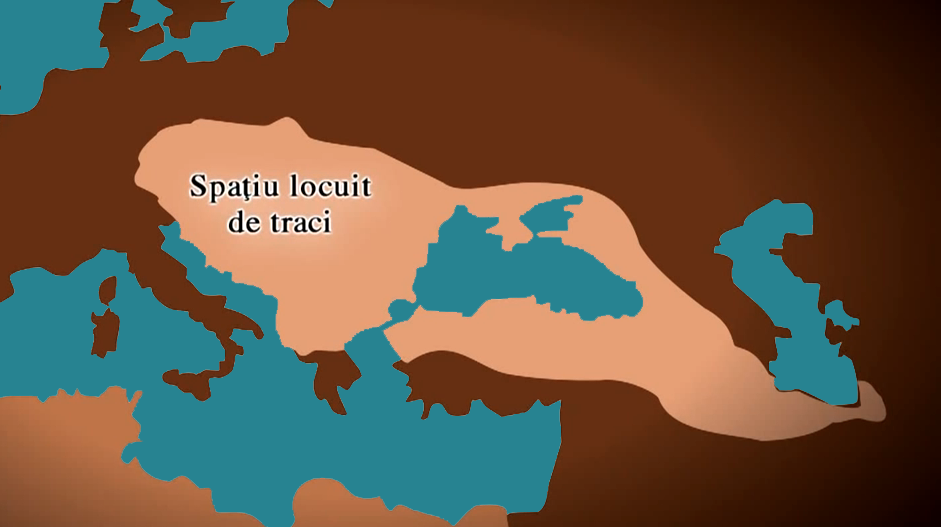
Recent paleo-genetic research shows the distribution of the Dacha people.
No wonder the Empire of Envy both honored and feared them.
The Roman Empire over time included 67 countries and 270 different ethnicities who spoke a similar number of languages. So why would just one of these countries learn their language so perfectly? Of course you guessed it: Italian was the original language of the Romanians / Dachians! Not the other way around. It has long been a historical secret because it has been deliberately obscured.
We must stop considering the Roman Empire as a country or an extension of a country. It was an organization, a metastructure, that was imposed on a number of countries. It was more like the multinational corporations today, that impose their marketing and worldview, their products, that infamous trade treaties, their corruption and greed, their lobbying, their administration and management, their mercenaries and staged wars for profit. It started in Babylon and ended with the Anglo-Saxon empire run by bankers and intelligence services.
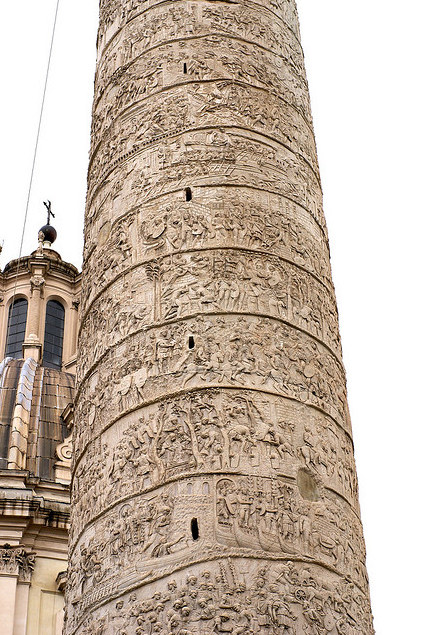
The Romans had enormous respect for the Dachians. Or the Thracians, another well-known group or tribe praised by Herodotus. Or the barbarians, a term that does not mean, what we mean today: savage, brutal and primitive. It simply meant a culture, where men let their beards grow unlike the Romans.
Or the Geet (the goats – with beards) as the Greeks called them. One can see their proud figures on the pillar of Trajan, the emperor who waged war against Decebel, their king. It’s like a giant cartoon strip wrapping around the monument. They do not look like people, who just lost their wars and forgot their language.
And they certainly did not, for the Dachian empire was huge and consisted of many tribes. When they were gathered under King Burebista and the much-loved Queen Tomyris – who annihilated King Cyrus from the mighty army of Persia – it stretched from Ukraine to the Black Sea to Serbia and to Macedonia. It was huge! The Dachians held the unoccupied territory as Dacii Liberi as opposed to the occupied territory which they called Dacia Romană, a Roman province – pro-vince in the sense won for Rome by force.
The Dacha language gave birth to vulgar Latin from which the Latin we know was created. So the story is told upside down by those, who considered themselves the victors and therefore had the means to impose their history on the outside world, no matter how inverted it was. And that gives us a problem since we have been presented with history based on forged history, which in turn is based on forged history… Rome is said to have been created by settlers from Troy and Aeneas, son of King Priam (Pryam) of Troy 753 f Kr – and was thus a Dachian colony.
That these peoples were in no way primitive is described by Greek and Byzantine historians. They were among other things famous for their craftsmanship and technology of mining and goldsmithing.
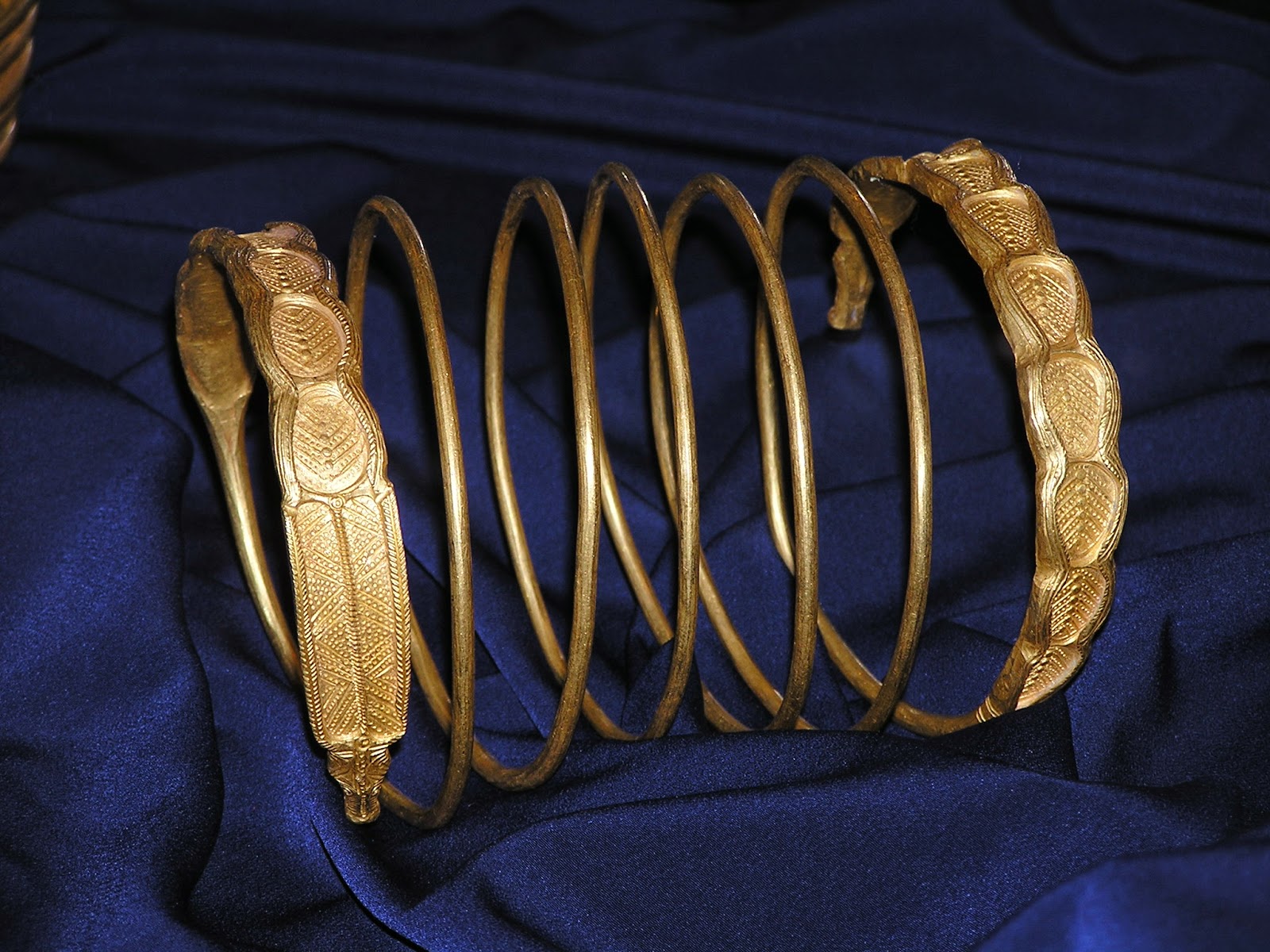
Barbarians with long beards created this masterpiece
Building knowledge – tech-know-logos, technology – and the extent of gold deposits was one of the reasons why the Romans wanted to occupy parts of Dachia. The Romans were technology thieves. They stole their famous water technology and aqueducts from the peoples they later wiped out or displaced: the Etruscans. The survivors moved to the Iberian Peninsula. A contemporary parallel would be the occupation and destruction of Libya – cf. Scipio’s mantra in the Senate: And by the way, I believe that Carthage should be destroyed – and the looting of the Libyan gold reserves and their water technology, The Man Made Project. It’s completely the same.
Romerne festede i tre måneder efter slaget mod dachierne. De hjembragte hundreder af tons guld og sølv. Den romerske befolkning behøvede ikke at betale skat et helt år for den romerske giganthær – husk at al skat er krigsskat, der er forlænget ind i fredstid. Parallellen i dag vil være den amerikanske hær, CIA og NATO’s megagesjæft med drughandel fra deres okkuperede områder.
So there was plenty of gold in Romania. The mines in the Rosea Mountains are 400 km long! They still contain a lot of gold, but some foreign company has the exclusive right to mine, and they pay nothing to the Romanians. On the other hand, the area is totally contaminated with lakes of cyanide. So who are these people and how did they get this unique privilege. It is not known, but one thing is certain: it has EVERYTHING to do with the overthrow of Ceausescu and the impoverishment of the population that took place in its wake.
There is a parallel to what happened in Libya, in Afghanistan, in Sudan, in Iraq in Syria and in Ukraine. And in Serbia. The same hidden hand never tells what it does and why. The hand sits on bankers, cartels, thieves and murderers. In their wake we will see coups, revolutions, civil wars and in the midst of this chaos the robbery takes place while people duck their heads and try to survive. The large gold reserves in Libya and Ukraine disappeared. Right now, U.S. troops have been seen carrying black boxes of all the gold that ISIS has stolen from the Syrians into armored vehicles, and the Syrians are blaming them openly for it. Oil production was destroyed in Iraq, where the oil fields were set on fire and then all the money that should have gone to the construction was stolen. The National Museum was looted. The same with the natural resources of Romania. In addition to the gold, the old trees in the national parks are felled and end up as firewood for wood stoves in Austria. Who gets bribed to allow it? Scumbags in suits run the world!
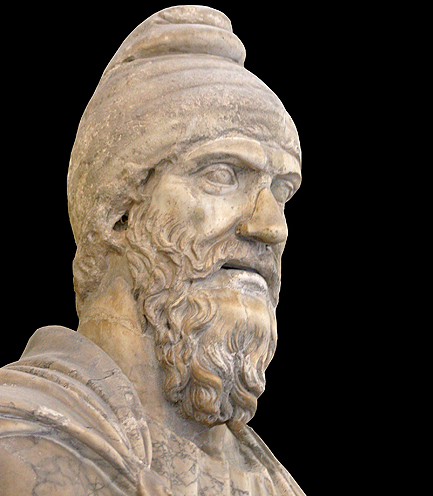
Tarabostes, a Phrygian-Dachian warrior with a hat and a beard
It is as if history repeats itself, though historians always deny that kind of ‘wet’. Well does not it? Apparently. Could the reason be that a story that is denied has to repeat itself? Psychologists can at least confirm this. When you lie to yourself and to others, the lie will one day sooner or later spring up in your face and force you to relive and revise it. A serial killer who does not get caught will do it over and over again, leaving more-and-more clues to get caught. The story points backwards and says: look here for what you have not seen. If we do not fully know ourselves and where we come from, history has a strange way of pulling us backwards.
Trajan, the Iberian-Roman emperor, said when he arrived in Thrace: ‘I will return to the home of my ancestors’. He knew it, because he had chiseled it on his pillar. But Rome did not destroy Dachien / Thrace. They only ruined their history for posterity. This story now returns with two purposes: to enrich us with the true story and hold us accountable for not having told the story for too long.

It is as if history repeats itself, though historians always deny that kind of ‘wet’. Well does not it? Apparently. Could the reason be that a story that is denied has to repeat itself? Psychologists can at least confirm this. When you lie to yourself and to others, the lie will one day sooner or later spring up in your face and force you to relive and revise it. A serial killer who does not get caught will do it over and over again, leaving more-and-more clues to get caught. The story points backwards and says: look here for what you have not seen. If we do not fully know ourselves and where we come from, history has a strange way of pulling us backwards.
Trajan, the Iberian-Roman emperor, said when he arrived in Thrace: ‘I will return to the home of my ancestors’. He knew it, because he had chiseled it on his pillar. But Rome did not destroy Dachien / Thrace. They only ruined their history for posterity. This story now returns with two purposes: to enrich us with the true story and hold us accountable for not having told the story for too long.
A fabled animal often seen in Dachasian mythology is the dragon wolf. There are two connections to something we have mentioned above. One is the dragon order of which Vlad Tepes and his father were members. Also remember that it was Rome that arranged his incarceration in Hungary. The other is the wolf mother who gave birth to Romulus and Remus, who according to the myth became the ancestors of Rome. Interesting ways to tell history without telling the whole cultural history.




